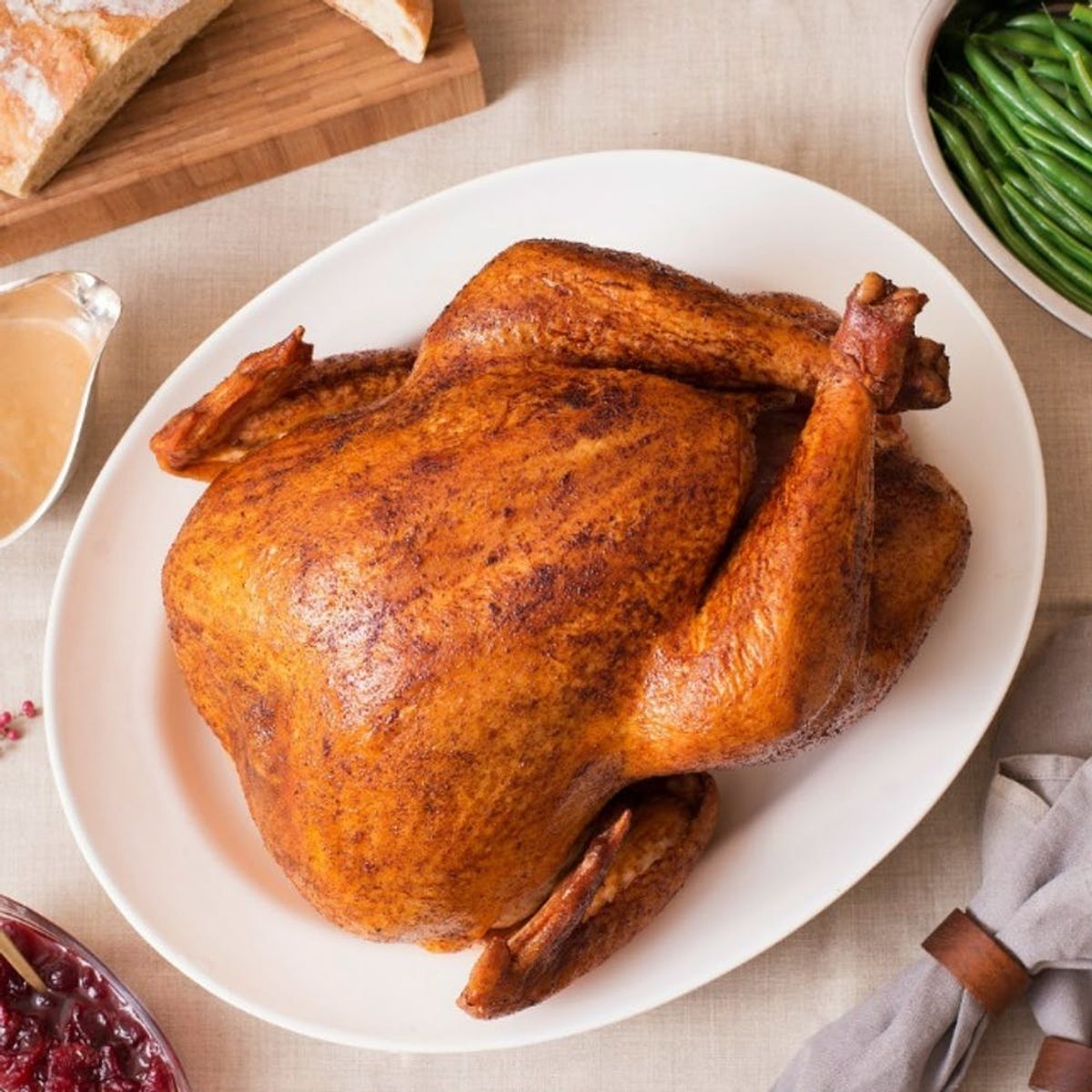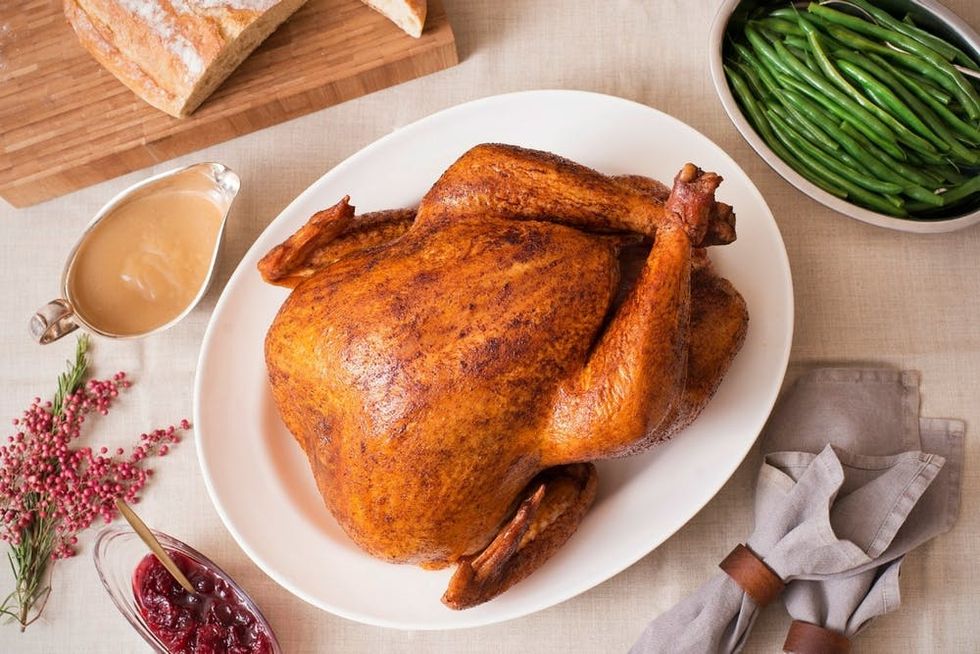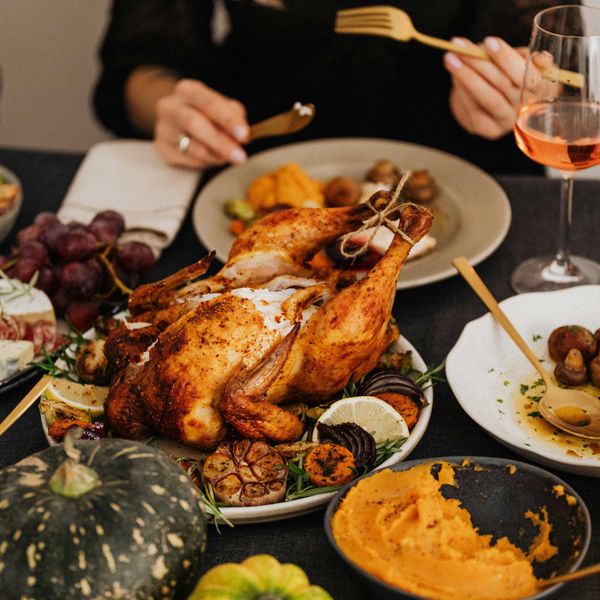Learn how to roast the perfect turkey like a pro.
Everything You Need to Know to Cook Your First Thanksgiving Turkey

So this year, you’re in charge of the true star of Thanksgiving: the turkey. Even seasoned cooks struggle to make their bird into a crisp, golden centerpiece. You may have mastered the art of spectacular stuffing or a fabulous pumpkin pie, but everything changes the first time you host the meal yourself. If anyone knows how to perfectly prep and roast a bird, it’s Heidi Diestel, a fourth-generation turkey farmer at Diestel Turkey Ranch. Read on for her most essential turkey tips.

Choosing Your Turkey
Being a turkey farmer, Diestel is picky about what her family eats at Thanksgiving. “I recommend looking for birds that are antibiotic free and have been vegetarian fed. It’s also best to seek out options that have nothing added to them, i.e. no salt solutions or fillers,” she tells us. The most important thing is buying the best turkey you can afford. Diestel says that the extra $1-$2 per pound really makes a difference. The bird will have a richer flavor, better texture, and more meat-to-bone ratio. If you want to go really gourmet, you can seek out an heirloom or heritage-breed turkey.
Stocking the Kitchen
There are a couple of special cooking tools that you might want to purchase for your first Thanksgiving turkey. Diestel recommends:
A roasting pan with a rack: This is the most essential item — a roasting pan large enough to fit your turkey. And make sure it comes with a roasting rack. “A roasting rack is great to use because it allows air to circulate around the whole bird while it roasts, resulting in perfectly golden, crispy skin,” says Diestel.
A carving set: “Purchase items like a nice carving set, which can be passed down throughout generations,” she advises.
Plastic or glass containers: “Don’t forget to have enough containers for leftovers!” Diestel says. “When my family celebrates Thanksgiving, we typically roast a 30+ pound bird for our group of 10-15 people, which leaves us with a lot of delicious turkey to enjoy over the next few days.”
Thawing the bird
If you buy a frozen turkey, you need to plan ahead to make sure it’s properly thawed before you pop it in the oven — otherwise, it won’t cook evenly. Keep the turkey in its plastic packaging and place it in the fridge.
Here are the USDA’s recommended refrigerator thawing times:
4 to 12 pounds — 1 to 3 days
12 to 16 pounds — 3 to 4 days
16 to 20 pounds — 4 to 5 days
Once your turkey is thawed, it should be cooked within two days. But if you’ve been checking your turkey and realize it won’t be fully thawed in time for your meal, Diestel recommends using the cold water bath method to thaw it. “Submerge the turkey (in its original bag) in cold tap water … Allow about 30 minutes per pound. Change the water every 30 minutes until the turkey is thawed, and cook the turkey immediately after it’s thawed,” adds Diestel.
Seasoning Your Turkey
Diestel suggests keeping the seasoning on your first turkey simple; once you become a turkey pro, you can experiment. She uses a mixture of olive oil, paprika, and salt. Rub it into the skin and the cavity of the bird before it goes into the oven.
Roasting it right
Diestel recommends a simple roast to let the flavor of the meat shine through. Here’s her family’s foolproof method:
1. Preheat oven to 325 degrees Fahrenheit. Remove thawed turkey from the bag. After removing the neck and giblets from the body cavities, pat the inside and outside of the bird dry with paper towels. If you choose to stuff your bird, this would be the time to do so.
2. Rub the exterior of the turkey with a blend of your favorite herbs and spices. Place the turkey in an open roasting pan fitted with a rack, breast side up. Cover the bottom of the pan with approximately two cups of water or broth. Place your turkey in the oven.
3. There’s no need to turn the bird while roasting, as it will brown to a rich, golden color. A foil tent can be placed loosely over the turkey during the last hour of roasting to prevent over-browning. When the turkey reaches the desired internal temperature (minimum of 165 degrees Fahrenheit), remove from the oven.
Remember, don’t baste your turkey throughout the cooking process, as it can make the skin soggy, not crispy. That said, doing so once can give you great gravy. “We always say that the key to a fabulous gravy is basting the bird with a hearty white wine about half to three-fourths of the way through the roasting time,” Diestel says. “The wine gives the gravy a fantastic base flavor.”
Once the bird is out of the oven, let it rest for 20-30 minutes before carving. “This allows time for the juices to seal within the meat and makes for a delicious finished product,” she explains.
Equipped with these tips, cooking your first turkey doesn’t have to be so daunting.
For more cooking advice from the pros, follow us on Pinterest.
Brit + Co may at times use affiliate links to promote products sold by others, but always offers genuine editorial recommendations.
(Photo via Diestel)



















